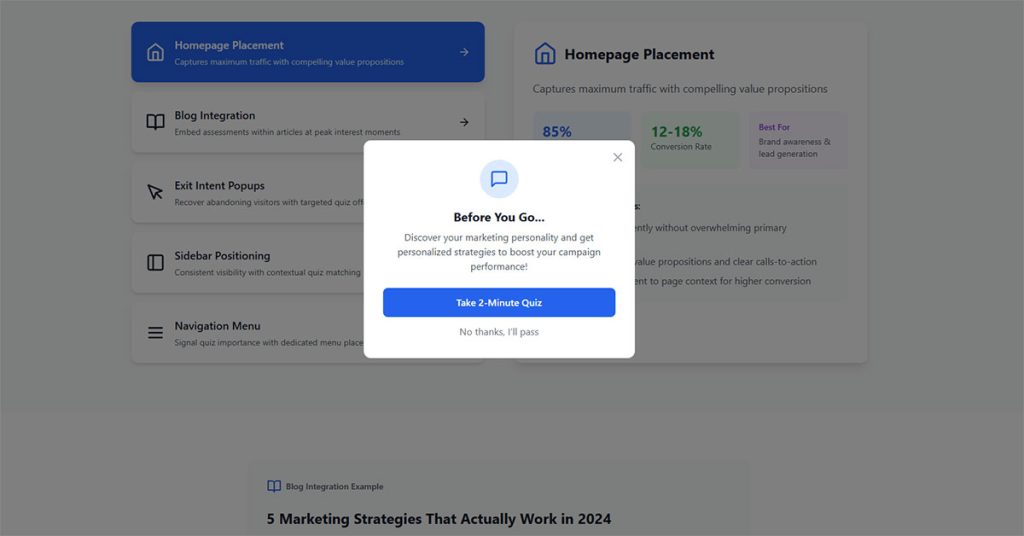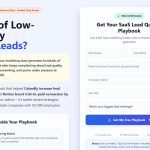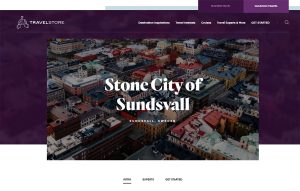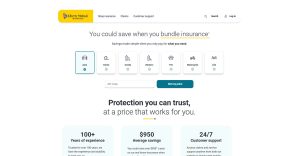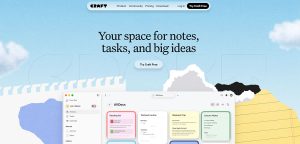Your website gets traffic, but your calendar stays empty. Lead generation for travel companies isn’t about attracting more visitors. It’s about converting browsers into bookers. Most travel businesses waste money…
Table of Contents
Traditional lead capture methods are dying. Using quizzes and interactive forms for lead generation has become the secret weapon smart marketers use to triple their conversion rates while building genuine audience engagement.
Static contact forms convert at dismal 2-5% rates. Interactive assessments consistently achieve 20-50% conversion rates because they provide immediate value before requesting personal information.
This comprehensive guide reveals proven strategies for creating high-converting quiz marketing campaigns that generate qualified prospects. You’ll discover specific question frameworks, technical implementation tactics, and optimization techniques that transform casual website visitors into eager customers.
What you’ll learn:
- Five quiz formats that capture qualified leads automatically
- Question design principles that boost completion rates
- Technical setup strategies for seamless CRM integration
- Follow-up sequences that convert quiz participants into customers
- Performance tracking methods that maximize ROI
Master these interactive content marketing strategies to build a lead generation funnel that works while you sleep.
Types of Lead Generation Quizzes and Interactive Forms
Interactive content marketing has revolutionized how businesses capture and qualify prospects. The average quiz conversion rate reaches 40.1% – meaning 4 out of 10 people become leads when they start a quiz.
Lead generation is the top priority for 85% of marketers in 2025. Interactive quizzes generate 40% more leads compared to traditional content formats.
Personality and Assessment Quizzes
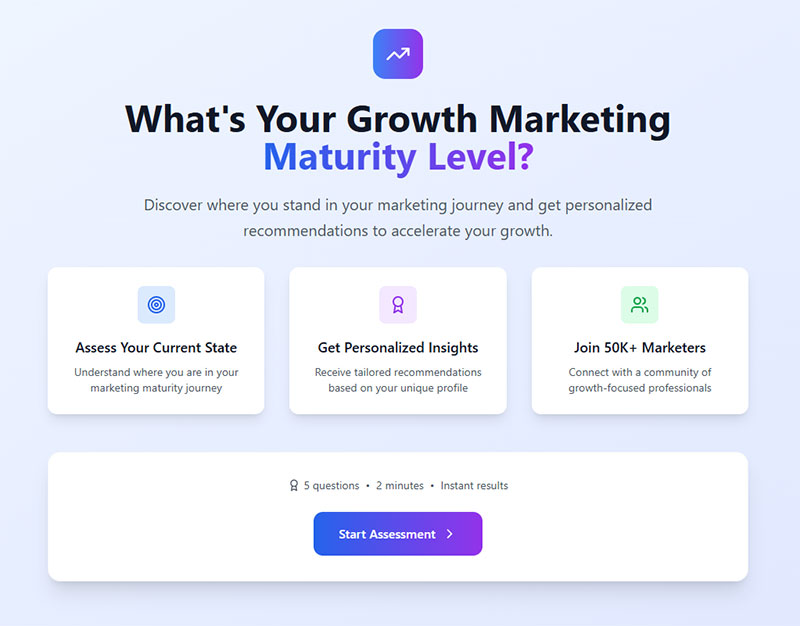
“What type of customer are you?” formats dominate social media engagement. These quizzes tap into human psychology while gathering behavioral insights.
Skills assessments work particularly well for B2B companies. A marketing agency might create “What’s Your Content Marketing Maturity Level?” to identify prospects needing their services.
Interactive content generates up to 80% higher engagement rates than traditional formats. Personality quizzes see completion rates of 70-90%.
Lifestyle evaluations capture preference data for your marketing automation tools. Fashion brands excel at “Find Your Style Personality” quizzes that segment audiences.
Industry-specific diagnostic tools generate highly qualified leads. Software companies use “IT Security Health Check” assessments to identify vulnerable organizations.
Case Study: Jenna Kutcher’s “Secret Sauce” quiz generated over 105,000 subscribers and became its own brand.
Product or Service Recommendation Quizzes
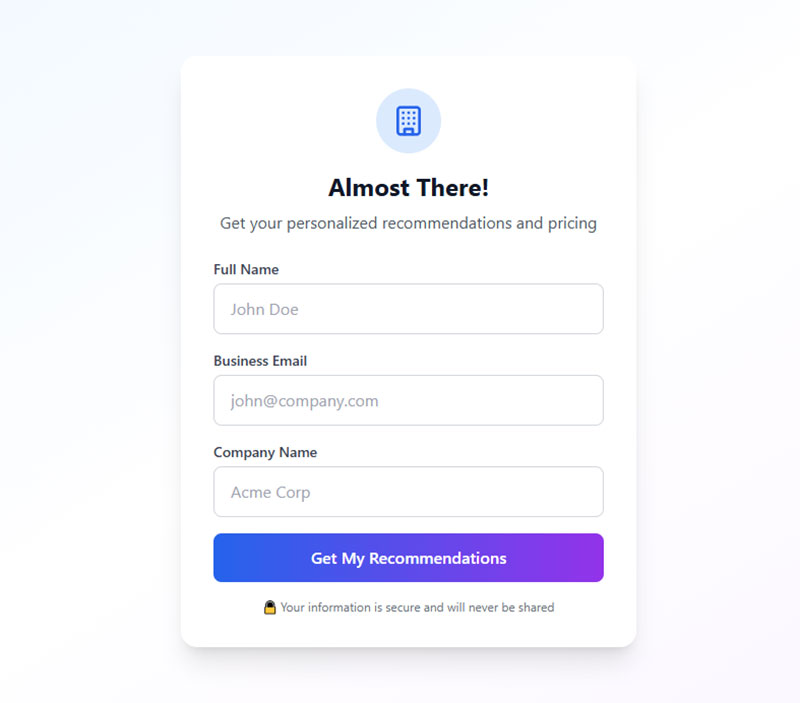
Recommendation engines disguised as quizzes drive impressive conversion rates. “Find your perfect skincare routine” formats collect customer information while steering users toward products.
Service matching works well for complex sales. Financial advisors ask about income, goals, and risk tolerance to recommend investment strategies.
Incorporating quizzes into sales funnels leads to a 33% increase in conversion rates. The interactive nature guides users through decision-making.
Budget assessments naturally qualify prospects. “What Should You Spend on Marketing?” quizzes help agencies identify qualified prospects.
Real Results: Henry’s House of Coffee achieved a 23% opt-in rate with their product quiz (vs 5% from pop-ups) and 9% purchase conversion rate.
Educational and Knowledge-Based Quizzes
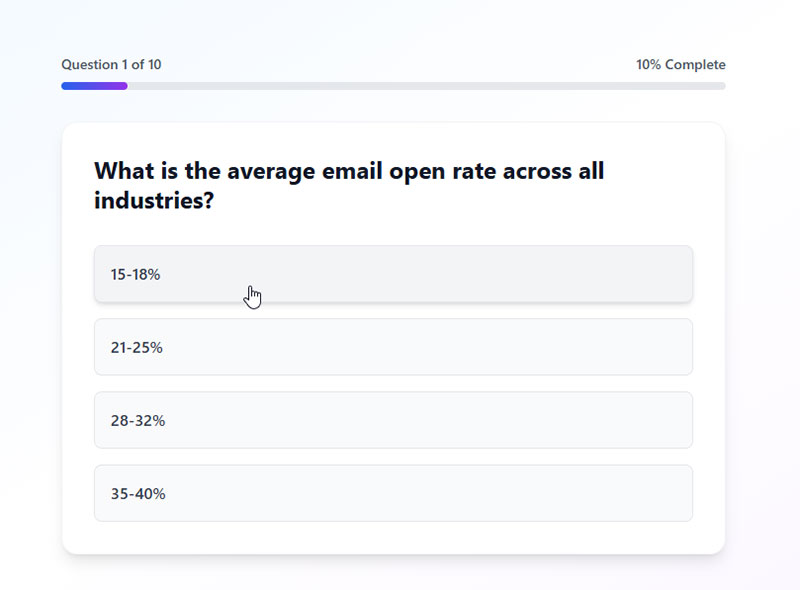
Industry knowledge tests establish expertise while identifying gaps. Marketing consultants use “Digital Marketing IQ Test” formats to demonstrate value.
74% of marketers use content marketing to generate leads. Educational quizzes position companies as thought leaders while capturing information.
Skill assessments create follow-up opportunities. “Rate Your Project Management Skills” can lead to training sign-ups or consulting inquiries.
Certification prep quizzes attract motivated learners. Training companies build email lists of engaged prospects ready to invest.
Success Story: Scott grew his email list from 2,000 to 70,000 subscribers using an interactive bird identification quiz.
Interactive Calculators and Tools

ROI calculators demonstrate value before sales conversations. SaaS companies use “Calculate Your Potential Savings” tools requiring contact information for results.
Companies using AI report 50% increases in lead generation and 47% higher conversion rates. Smart calculators provide personalized recommendations.
Health and fitness calculators collect personal data while providing value. “BMI and Fitness Goal Calculator” helps nutrition brands segment audiences.
Business planning worksheets attract serious prospects. “Cash Flow Projection Tool” helps consultants identify qualified leads.
Users spend 47% more time engaging with interactive formats vs passive alternatives.
Multi-Step Lead Qualification Forms
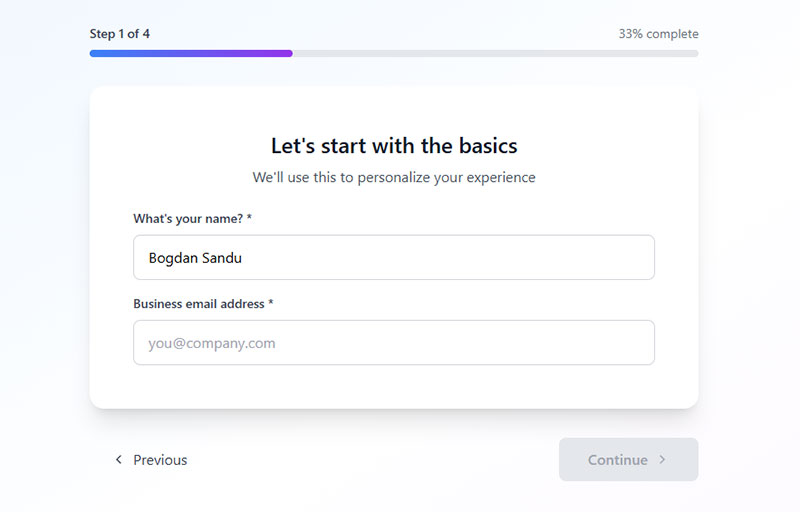
Progressive profiling reduces form abandonment while gathering detailed information. 68.32% of page viewers start forms, with 65.99% completing them when properly designed.
78% of marketers using progressive profiling report better lead quality compared to traditional single-form approaches.
Branching logic creates personalized experiences. Multi-step forms adjust questions based on previous answers.
Key Stats:
- Average form completion: 2 minutes 37 seconds
- Average abandonment: 1 minute 43 seconds
- Progressive forms show better completion rates
Start with basic info (name, email) first. Gradually collect detailed data like company size and budget during follow-up interactions.
Implementation Best Practices
Email marketing is the top lead generation channel for 48% of marketers. Integrate quiz results with email automation for maximum impact.
Cost per lead varies by channel:
- Online retargeting/SEO: $31
- Email marketing: $53
- Events/trade shows: $811
Mobile optimization matters: Conversion rates are 2.8% mobile, 2.8% desktop, 3.1% tablet.
Scale for results: Businesses see 55% increases in leads when expanding from 10 to 15 landing pages.
Interactive content generates conversions 70% of the time vs 36% for passive content. Match format to purpose, keep barriers low, and use progressive profiling to build comprehensive customer profiles.
Planning Your Quiz or Interactive Form Strategy
Strategic planning determines whether your interactive content generates qualified leads or just vanity metrics.
Interactive content generates 52.6% more engagement than static content. Users spend 13 minutes on interactive elements versus just 8.5 minutes on traditional content.
Identifying Your Target Audience and Their Pain Points
Detailed buyer personas form the foundation of effective quiz marketing strategies.
Companies that exceed revenue targets are 2.4 times more likely to use personas effectively than those missing their goals.
Key research areas:
- Customer journey mapping reveals optimal quiz placement and timing
- Decision-making triggers vary by audience segment
- Competitor analysis reveals content gaps you can exploit
71% of companies exceeding lead goals have documented buyer personas. The difference? They understand what drives customer decisions beyond basic demographics.
Setting Clear Lead Generation Goals
Quality versus quantity decisions impact every design choice.
Quizzes achieve conversion rates of 40-50% – significantly higher than traditional lead magnets. The overall start-to-lead rate holds steady at 40.1%, meaning 4 out of 10 people become leads when they start your quiz.
Important benchmarks:
- Only 27% of B2B leads are sales-ready when generated
- Professional services see 4.6% conversion rates (highest)
- B2B e-commerce averages 1.8% conversion rates
Lead scoring criteria should align with sales team requirements. Define what constitutes a qualified lead before building your quiz.
Choosing the Right Quiz Type for Your Business
Business model alignment is crucial for success.
Interactive assessments are used by 54% of marketers – making them the most common interactive content type.
Top 5 most successful formats:
- Contests and games
- Personality and recommendation quizzes
- Dynamic infographics
- Assessment tools
- Polls and surveys
Match quiz type to customer journey stage:
- Awareness stage: Educational content and personality tests
- Consideration stage: Product recommendation tools
- Decision stage: Qualification assessments
Creating Compelling Quiz Topics and Titles
Curiosity-driven headlines dramatically impact participation rates.
“What’s Your Marketing Personality?” generates more clicks than “Marketing Assessment.”
Companies using buyer personas see 6X higher engagement when targeting cold leads. This comes from understanding exactly what language resonates.
Effective title strategies:
- Focus on benefits, not features
- Address specific pain points
- Capitalize on trending industry topics
- A/B test different versions
Interactive content converts twice as well as passive content – but only with compelling titles that capture attention.
The most successful campaigns combine strategic planning with audience understanding. Email marketing delivers $42 for every $1 spent, making quiz-generated leads extremely valuable when properly nurtured.
Designing High-Converting Quiz Questions
Question design determines completion rates and lead quality. Poor structure kills engagement. Smart formatting drives conversions.
Structuring Questions for Maximum Engagement
Start simple. First questions should be easy and enjoyable. “What’s your biggest marketing challenge?” works better than complex budget inquiries upfront.
Build complexity gradually as users invest time. Early engagement creates psychological commitment to completion. Visual elements boost interaction rates significantly.
Clear, focused questions prevent confusion. Avoid double-barreled inquiries that ask multiple things simultaneously. Each question should address one specific point.
Multimedia integration keeps users engaged longer. Images, videos, and interactive elements transform boring surveys into dynamic experiences that encourage completion.
Question Types That Drive Completion
Multiple choice with appealing options performs best across all demographics. Provide 3-5 choices that cover the spectrum without overwhelming users.
Image-based selection questions work exceptionally well on mobile devices. “Which workspace style motivates you?” with office photos generates higher engagement than text-only alternatives.
Slider inputs create interactive experiences while gathering precise data. Budget ranges, satisfaction levels, and priority rankings work well with this format.
Yes/no questions move users quickly through qualification sequences. Strategic placement prevents form abandonment while capturing essential data points.
Writing Questions That Qualify Leads
Budget qualification requires careful timing and positioning. Place financial questions after engagement builds but before requesting contact information.
Decision-making authority identification separates influencers from decision-makers. “Who typically makes purchasing decisions for marketing tools at your company?” reveals organizational dynamics.
Pain point discovery questions provide valuable sales intelligence. “What keeps you awake at night regarding your marketing results?” generates insights for follow-up conversations.
Contact preference and timing questions respect user autonomy while enabling appropriate follow-up. This builds trust and improves conversion rates.
Using Conditional Logic and Branching
Personalized question paths eliminate irrelevant inquiries. B2B software companies can branch enterprise customers toward different questions than small business users.
Smart branching improves user experience flow significantly. HubSpot and Marketo both excel at creating adaptive questionnaires that feel conversational rather than robotic.
Targeted information collection increases lead quality scores. Form builders with conditional logic enable sophisticated qualification without overwhelming users.
Advanced platforms like Outgrow and Typeform make complex branching accessible to non-technical users through drag-and-drop interfaces.
Creating Irresistible Results and Lead Magnets
Results determine whether users share contact information. Weak outcomes kill conversion rates. Valuable insights drive lead generation success.
Designing Valuable Quiz Results
Actionable insights separate great quizzes from mediocre ones. “You’re a Visual Learner” means nothing without specific recommendations for improvement.
Personalized recommendations based on quiz responses create immediate value. Marketing assessments should suggest specific tactics, tools, or strategies relevant to user answers.
Clear next steps guide users toward desired actions. “Based on your results, consider implementing these three email marketing strategies” provides direction and establishes expertise.
Shareable content amplifies reach organically. Results that users want to post on LinkedIn or share with colleagues multiply your audience without additional advertising spend.
Connecting Results to Lead Magnets
Result-specific offers dramatically improve conversion rates. Someone scoring “Beginner” on a marketing assessment needs different resources than “Advanced” users.
Logical content progressions feel natural rather than pushy. Quiz results about social media challenges can naturally lead to social media strategy guides or templates.
Immediate value delivery builds trust essential for ongoing relationships. Email the complete results instantly rather than promising future delivery.
Resource matching demonstrates understanding of user needs. Klaviyo excels at connecting quiz outcomes to relevant email sequences and product recommendations.
Crafting Results That Encourage Social Sharing
Visually appealing graphics increase sharing likelihood by 650% compared to text-only results. Canva and similar tools make professional-looking result images accessible.
Engaging descriptions that capture personality or professional insights motivate sharing. “You’re a Strategic Marketing Visionary” sounds more shareworthy than “Marketing Type A.”
Social proof elements like “Join 10,000+ other Strategic Visionaries” create community belonging that encourages participation in sharing.
Sharing incentives such as bonus content for social posts can multiply your organic reach exponentially.
Using Results for Lead Segmentation
Outcome-based tagging enables precise marketing automation workflows. ActiveCampaign and ConvertKit both support sophisticated segmentation based on quiz results.
Targeted email sequences deliver relevant content that converts better than generic campaigns. Lead scoring algorithms can automatically assign points based on quiz outcomes.
Personalized follow-up communications reference specific quiz results, creating continuity that feels like ongoing conversation rather than random outreach.
Product recommendations aligned with quiz outcomes improve sales conversion rates. E-commerce brands using this approach see 25-40% higher average order values from quiz-generated leads.
Smart marketers combine engaging questions with valuable results to create lead capture forms that users actually want to complete. The key lies in balancing qualification needs with genuine value delivery.
Technical Implementation and Tools
Platform choice determines quiz functionality and integration capabilities. Wrong tools kill conversion potential.
Choosing the Right Quiz Platform
Typeform leads for user experience and visual appeal. Clean interface design and smooth animations keep users engaged through completion.
Outgrow excels at complex calculators and branching logic. Advanced features support sophisticated B2B qualification workflows that simpler platforms cannot handle.
JotForm offers robust integration capabilities with affordable pricing. Strong option for businesses needing WordPress forms with quiz functionality.
Interact specializes in personality quizzes with built-in social sharing features. Marketing agencies favor this platform for client campaigns focused on engagement over qualification.
SurveyMonkey provides enterprise-grade analytics and reporting. Large organizations requiring detailed data analysis and compliance features choose this option.
Pricing varies dramatically. Basic Typeform plans start at $25/month while enterprise Outgrow implementations can exceed $1000/monthly.
Integrating with Your Marketing Stack
CRM connections enable automatic lead scoring and assignment. Salesforce, HubSpot, and Pardot integrations sync quiz data directly into sales workflows.
Email marketing platforms like Mailchimp, ConvertKit, and ActiveCampaign receive segmented leads automatically. No manual exports or data entry required.
Analytics setup tracks user behavior beyond simple completion rates. Google Analytics goals and event tracking reveal optimization opportunities.
Sales team notifications trigger immediate follow-up for high-scoring prospects. Slack integrations and mobile alerts ensure hot leads receive attention quickly.
Mobile Optimization and User Experience
Responsive design is non-negotiable. Over 60% of quiz traffic comes from mobile devices, making touch-friendly interfaces essential.
Loading speed optimization prevents abandonment. Compress images, minimize scripts, and use content delivery networks to maintain sub-3-second load times.
Cross-device compatibility ensures seamless experiences. Users might start quizzes on phones and finish on desktops, requiring synchronized progress tracking.
Touch-friendly interface design accounts for finger navigation. Buttons need adequate spacing and clickable areas to prevent frustration.
Data Collection and Privacy Compliance
GDPR compliance requires explicit consent and transparent data usage policies. Creating GDPR compliant forms protects both users and businesses from regulatory issues.
Secure data storage practices prevent breaches that destroy trust and trigger penalties. SSL certificates and encrypted databases are baseline requirements.
User consent mechanisms must be clear and granular. Pre-checked boxes violate regulations in many jurisdictions.
Privacy policy integration explains data usage, storage duration, and user rights in accessible language.
Optimizing Quiz Performance and Conversion Rates
Data-driven optimization transforms mediocre quizzes into lead generation powerhouses. Testing reveals unexpected improvement opportunities.
A/B Testing Quiz Elements
Headlines impact participation rates more than any other element. “Discover Your Marketing Personality” typically outperforms “Marketing Assessment Quiz” by 40-60%.
Question format testing reveals audience preferences. Image-based questions might work better for B2C while text performs well in professional contexts.
Result presentations affect sharing and conversion rates. Visual results with actionable recommendations convert better than text-heavy outputs.
Completion rate monitoring identifies problematic questions. Drop-off spikes indicate confusing or irrelevant content that needs revision.
Analyzing User Behavior and Drop-off Points
Abandonment patterns reveal optimization opportunities. Users typically drop off at question 3-4 if initial engagement fails.
Time-to-complete tracking identifies pacing issues. Quizzes taking over 3 minutes see significant abandonment unless value is extraordinary.
Device and traffic source analysis helps optimize user experience. Mobile users might need shorter quizzes than desktop visitors.
Heatmap analysis shows interaction patterns that inform design improvements. Tools like Hotjar reveal which elements capture attention.
Improving Question Flow and User Experience
Cognitive load reduction prevents overwhelm. Limit choices to 3-5 options and avoid complex multi-part questions.
Progress indicators maintain momentum through longer assessments. Visual progress bars reduce perceived effort and encourage completion.
Clear instructions eliminate confusion that causes abandonment. Each question should be self-explanatory without additional context.
Encouraging microcopy boosts completion rates. “You’re doing great!” or “Almost done!” messages maintain engagement.
Conversion Rate Optimization Techniques
Streamlined lead capture reduces friction at critical moments. Request minimal information initially, then use progressive profiling for additional data.
Trust signals like testimonials, security badges, and company logos increase form completion rates by 15-25%.
Call-to-action optimization focuses on value rather than action. “Get My Personalized Results” converts better than “Submit.”
Form validation prevents errors that frustrate users. Real-time feedback catches mistakes before submission attempts.
Exit-intent popups can rescue abandoning users. “Wait! Get your results before leaving” messages recover 10-15% of lost completions.
Smart optimization combines technical excellence with user-focused design. Successful quizzes balance data collection needs with genuine value delivery, creating experiences users want to complete and share.
Promoting Your Quizzes and Interactive Forms
Distribution strategy determines quiz reach and lead volume. Smart promotion multiplies organic engagement.
Website Integration Strategies

Homepage placement captures maximum traffic but requires compelling value propositions. Position quizzes prominently without overwhelming primary navigation.
Blog integration works exceptionally well for educational content. Embed relevant assessments within articles to capture engaged readers at peak interest moments.
Exit intent popups recover abandoning visitors effectively. “Before you go, discover your marketing personality!” can capture 15-25% of otherwise lost traffic.
Sidebar positioning provides consistent visibility across pages. Use contextual quizzes that match page content for higher conversion rates.
Navigation menu integration signals quiz importance. “Find Your Solution” links in main menus generate steady participation from motivated visitors.
Social Media Promotion Tactics
Platform-specific strategies maximize engagement. LinkedIn works best for professional assessments while Instagram favors personality and lifestyle quizzes.
Teaser content builds anticipation before quiz launches. “Can you guess your marketing personality? Take our quiz tomorrow!” generates saved posts and return visits.
Social proof amplifies credibility. Share completion numbers, testimonials, and user-generated results to encourage participation.
Influencer partnerships extend reach within target demographics. Micro-influencers often provide better engagement rates than celebrity endorsements for niche audiences.
Email Marketing Integration
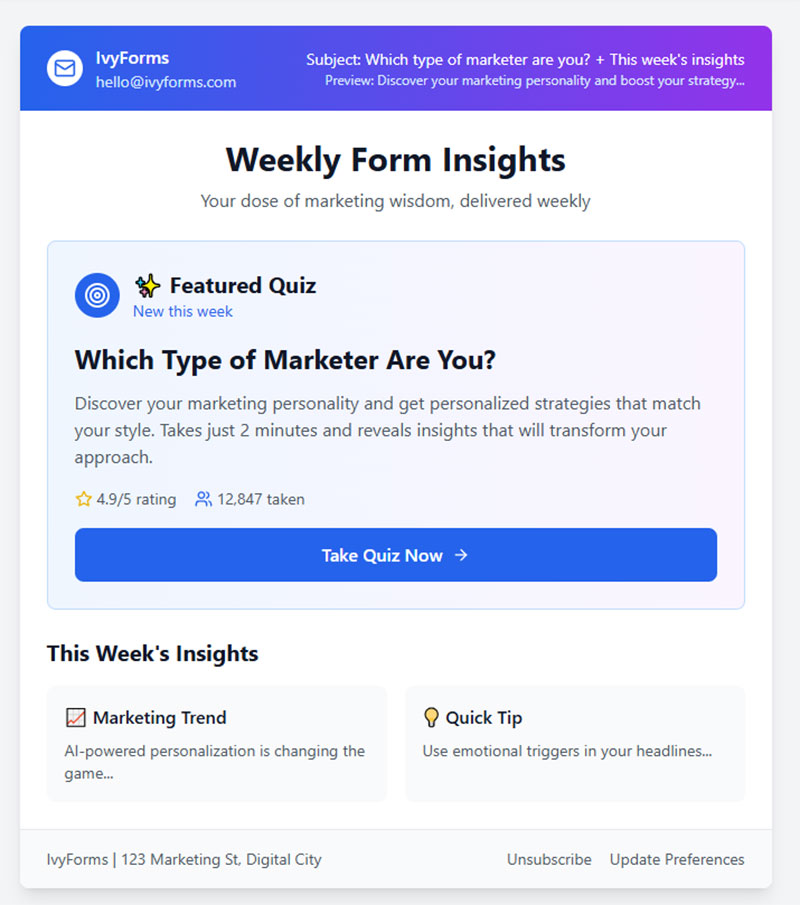
Newsletter inclusion reaches engaged subscribers first. Feature new quizzes prominently with compelling subject lines like “Which type of marketer are you?”
Quiz-specific campaigns generate higher open rates than generic newsletters. Segment lists by interests and send targeted quiz invitations.
Re-engagement strategies use quizzes to revive inactive subscribers. “We miss you! Take this quick quiz to update your preferences” often reactivates dormant contacts.
Welcome series integration introduces new subscribers to valuable assessments. Position quizzes early in onboarding sequences for maximum participation.
Paid Advertising and Promotion
Facebook Lead Ads integrate quiz experiences within the platform. Users complete assessments without leaving social feeds, reducing friction significantly.
Google Ads targeting quiz-related keywords captures intent-driven traffic. “Marketing assessment” and “business quiz” searches indicate high engagement potential.
Retargeting campaigns re-engage quiz abandoners. Show specific ads to users who started but didn’t complete assessments, offering incentives for return visits.
LinkedIn advertising excels for B2B quiz promotion. Target specific job titles, industries, and company sizes with relevant professional assessments.
Following Up and Nurturing Quiz Leads
Post-quiz engagement determines lead conversion success. Poor follow-up wastes qualified prospects.
Immediate Follow-up Strategies
Instant result delivery maintains engagement momentum. Email complete analyses immediately rather than promising future delivery.
Welcome sequences introduce your brand and establish expertise. Send 3-5 emails over two weeks with valuable content related to quiz outcomes.
Personalized thank-you messages reference specific quiz results. “Thanks for taking our Marketing Maturity Assessment, Sarah! Your ‘Growth-Focused’ results show…” creates connection.
Quick-win resources provide immediate value. Share relevant templates, checklists, or guides that address quiz-identified needs.
Segmented Email Nurturing Campaigns
Result-based sequences deliver targeted content. “Beginner” marketers need different resources than “Advanced” practitioners.
Progressive education builds expertise over time. Share increasingly sophisticated content that matches subscriber knowledge levels and interests.
Soft-sell approaches maintain trust while introducing solutions. Educational content with subtle product mentions converts better than aggressive sales pitches.
Automated workflows trigger based on quiz scores and engagement patterns. High-scoring prospects enter sales sequences while others receive nurturing content.
Sales Team Handoff Processes
Lead scoring integration prioritizes hot prospects. Quiz responses indicating budget, timeline, and authority trigger immediate sales attention.
Automated notifications alert sales teams to qualified leads. Slack integrations and mobile alerts ensure rapid response to high-value prospects.
Context-rich information helps sales conversations. Provide quiz results, responses, and behavioral data to enable personalized outreach.
Timing guidelines optimize contact success. Call within 5 minutes for maximum connection rates, or schedule based on prospect preferences indicated in quizzes.
Long-term Relationship Building
Ongoing value delivery maintains engagement beyond initial conversion. Share industry insights, trends, and exclusive content with quiz subscribers.
Community building creates belonging and loyalty. Facebook groups or Slack channels for quiz participants foster ongoing engagement.
Feedback collection improves quiz experiences and identifies new content needs. Regular surveys help refine targeting and question design.
Loyalty programs reward engaged subscribers. Offer exclusive access to new quizzes, premium content, or special discounts based on participation history.
Advanced marketers combine strategic promotion with sophisticated nurturing to maximize quiz ROI. Success requires consistent value delivery and patient relationship building that transforms quiz participants into loyal customers.
Measuring Success and ROI
Data drives quiz optimization and budget allocation decisions. Track metrics that matter.
Key Performance Indicators to Track
Completion rates reveal quiz engagement quality. Industry benchmarks range from 20-50% depending on length and complexity.
Lead conversion percentages measure capture effectiveness. Well-designed quizzes convert 40-70% of completers into leads.
Lead quality scores indicate sales potential. Track progression from quiz leads to qualified prospects to closed deals.
Cost per lead metrics compare quiz performance against other channels. Include development costs, promotion spend, and platform fees for accurate calculations.
Analyzing Lead Quality and Sales Impact
Lead-to-customer conversion rates determine quiz ROI. B2B quizzes typically convert 15-25% of leads into customers over 6-12 months.
Average deal size analysis reveals quiz impact on revenue quality. Educational assessments often generate higher-value prospects than generic contact forms.
Sales cycle comparison shows qualification effectiveness. Quiz-generated leads often close 30-40% faster due to better initial qualification.
Customer lifetime value assessment demonstrates long-term quiz impact. Engaged prospects who complete assessments show higher retention rates.
ROI Calculation Methods
Direct revenue attribution tracks sales directly linked to quiz participation. Use UTM codes and CRM tagging for accurate tracking.
Cost comparison includes all expenses: platform fees, development time, promotion costs, and staff resources.
Long-term value assessment considers ongoing customer relationships beyond initial sales. Quiz leads often generate higher lifetime values.
Brand awareness impact measurement captures indirect benefits through social sharing and organic reach expansion.
Continuous Improvement Strategies
Regular performance reviews identify optimization opportunities quarterly. Analyze completion rates, lead quality, and conversion trends.
User feedback collection reveals experience gaps. Post-quiz surveys and follow-up calls provide improvement insights.
Quiz refresh cycles prevent content staleness. Update questions, results, and design every 6-12 months based on performance data.
New format experimentation keeps content fresh. Test conversational forms, interactive calculators, and assessment variations.
Best Practices and Common Mistakes to Avoid
Strategic execution separates successful quiz campaigns from wasted efforts. Learn from common failures.
Quiz Design Best Practices
Keep assessments focused and concise. 5-8 questions typically maximize completion without sacrificing qualification depth.
Use clear, engaging language that matches your audience’s communication style. Professional tone for B2B, casual for lifestyle brands.
Provide genuine value in results rather than superficial categorizations. Actionable insights build trust and encourage lead conversion.
Make experiences enjoyable through visual design and interactive elements. Entertainment value increases completion and sharing rates.
Lead Capture Optimization
Time capture requests strategically. Ask for contact information after users invest time but before revealing complete results.
Request minimum required information initially. Name and email address often suffice for effective follow-up campaigns.
Be transparent about data usage and follow-up expectations. Clear privacy statements build trust essential for conversion.
Provide immediate value exchange. Deliver promised results instantly rather than requiring additional steps.
Common Pitfalls and How to Avoid Them
Overly long quizzes kill completion rates. Limit assessments to 3-5 minutes maximum unless extraordinary value justifies longer investment.
Collecting irrelevant information confuses users and reduces quality perceptions. Every question should serve qualification or engagement purposes.
Poor follow-up wastes qualified prospects. Have automated sequences ready before launching quiz campaigns.
Ignoring mobile form optimization alienates majority traffic sources. Test thoroughly on smartphones and tablets.
Industry-Specific Considerations
B2B versus B2C approaches require different strategies. Professional audiences need qualification-focused questions while consumers prefer personality-driven assessments.
Regulatory compliance varies by industry. Healthcare and financial services need stricter privacy protections and consent mechanisms.
Professional tone decisions impact credibility. Legal and consulting firms need formal language while lifestyle brands benefit from casual communication.
Question types should match industry norms. Technical assessments work for software companies while preference-based quizzes suit retail brands.
Successful quiz marketing combines strategic planning with meticulous execution. Focus on delivering genuine value while capturing qualification data that enables effective follow-up and conversion.
FAQ on How To Use Quizzes & Interactive Forms
What platforms work best for creating lead generation quizzes?
Typeform excels for visual appeal and user experience. Outgrow handles complex branching logic and calculators. JotForm integrates well with WordPress forms. Choose based on complexity needs, budget, and existing marketing stack compatibility.
How many questions should a lead generation quiz include?
5-8 questions maximize completion rates without sacrificing qualification depth. Longer assessments see dramatic drop-off after question 7. Mobile users prefer shorter formats. Educational quizzes can extend to 10 questions if extraordinary value justifies the time investment.
When should I ask for contact information during the quiz?
Request details after engagement builds but before revealing complete results. Position lead capture forms at 60-80% completion. This timing balances user investment with conversion optimization while maintaining trust and completion momentum.
What types of questions generate the highest quality leads?
Budget qualification, decision-making authority, and pain point discovery questions identify serious prospects. Timeline inquiries reveal purchase urgency. Company size and industry data enable precise targeting. Mix qualification with engaging personality elements for balanced conversion rates.
How do I integrate quiz results with my CRM and email marketing?
Most platforms connect with Salesforce, HubSpot, Mailchimp, and ActiveCampaign through native integrations or Zapier. Tag leads based on quiz outcomes for automated segmentation. Use conditional logic to trigger specific workflows and follow-up sequences.
What conversion rates should I expect from lead generation quizzes?
Well-designed quizzes convert 40-70% of completers into leads, significantly higher than traditional contact forms at 2-5%. Quiz completion rates range from 20-50% depending on length and value proposition. B2B assessments typically see lower volume but higher quality.
How do I create quiz results that encourage social sharing?
Design visually appealing result graphics with personality insights. Write engaging descriptions that users want to share professionally or personally. Include social proof elements and sharing incentives. Form design impacts shareability significantly through visual appeal.
What follow-up strategies work best for quiz leads?
Send personalized results immediately with relevant lead magnets. Create result-specific email sequences that provide ongoing value. High-scoring prospects enter sales workflows while others receive nurturing content. Maintain engagement through educational resources and community building.
How do I ensure mobile optimization for quiz forms?
Use responsive design with touch-friendly interfaces. Optimize loading speeds under 3 seconds. Test thoroughly across devices and browsers. Mobile form best practices include adequate button spacing, simplified navigation, and progressive profiling to reduce friction.
What metrics should I track to measure quiz ROI?
Monitor completion rates, lead conversion percentages, and lead quality scores. Track cost per lead compared to other channels. Measure lead-to-customer conversion rates and average deal sizes. Include development costs, platform fees, and promotion expenses for accurate ROI calculations.
Conclusion
Mastering how to use quizzes and interactive forms for lead generation transforms struggling campaigns into conversion powerhouses. Interactive content marketing delivers superior results compared to static landing page forms that most businesses still rely on.
Smart implementation requires strategic planning, technical excellence, and continuous optimization. Choose platforms like Outgrow or Interact that match your complexity needs. Design questions that qualify prospects while providing genuine value.
Key success factors include:
- Mobile-optimized form UX design that reduces abandonment
- Automated CRM integration for seamless sales workflows
- Result-based segmentation enabling personalized follow-up
- Regular A/B testing of question formats and completion incentives
Customer acquisition costs decrease significantly when quiz participants convert at 40-70% rates versus traditional methods. Focus on delivering actionable insights that build trust and establish expertise.
Start with simple personality assessments, then expand into calculators and diagnostic tools as confidence grows. Your marketing automation tools will thank you.


